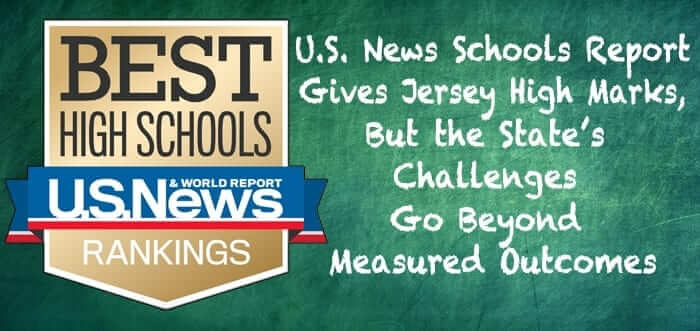U.S. News Schools Report Gives Jersey High Marks, But the State’s Challenges Go Beyond Measured Outcomes
The rankings are out and New Jersey Schools earned 25 gold medals and 106 total medals, a slight drop from 2016, from 31 gold medals and 109 total medals. According to the 2017 U.S. News Report: Best High Schools, the highest ranked NJ school, High Technology H.S., came in #16, with the highest overall ranking going to BASIS School in Scottsdale, Az.
According to Wallethub, there is plenty to be proud of for Garden State students, families, and educators. New Jersey ranks as the top state to work in as a teacher, where teachers experience one of the best teacher-student ratios, are in the top five for spending per student, and are in the top ten for highest salaries. On the 2017 Niche report of best high schools, which factors in more data than the U.S. News Report (i.e. health, safety, parent input), Bergen County Academies was ranked 14th in the country. Overall, NJ had four schools in the top 25 of the country.
The Quality Counts report, ranked New Jersey second in the Chance for Success Index, a measure of the role of education in an individual’s life. Additionally, New Jersey ranked third in K-12 Achievement, an index that measures performance of public school in 18 indicators.
Challenges for New Jersey schools make these distinctions even more impressive. New Jersey is in the top six states in the U.S. for diversity and has one of the greatest disparities, costing between $8,400 and $100,000 per student. Superintendent for Westampton School District, Virginia Grossman, has become well versed on this topic, spending nearly half of her insufficient professional development budget on the single topic of multicultural awareness.
“New Jersey ranked below average in two other categories, scoring a C (and ranking 44) for standards, assessments and accountability and D+, and a 38 ranking, for teaching profession. According to this same report, New Jersey has no incentives for teachers or principals working in hard-to-staff disciplines or targeted schools, no salary parity with other occupations, and no financial incentives for teachers to earn national certifications.”
As with any measurement, it’s important to consider how surveys arrive at their conclusions. The selection criteria for U.S. News Top High Schools involves a recently amended four step process, including expectation comparisons within state, performance of disadvantaged students, graduation rates, and college readiness performance. Just under 30,000 schools in all 50 states are considered, narrowed down to nearly two thirds after enrollment disqualifications.
Last year’s top school in New Jersey, High Technology H.S. in Lincroft, attributes their success to having some of the “most motivated and hard-working students apply,” according to the school’s humble principal Mr. Kevin Bals. He attributes the strong climate of the school to the kind and caring way students and staff treat one another. Parental involvement was cited as another strong contributor to student success.
While the selection criteria for the U.S. News Report focuses on outcomes, such as graduation rates, they aren’t the only measures of successful schools. Important intangibles were not part of the equation, such as the engagement of students and faculty in social-emotional learning. With Gallup showing very low polling numbers around engagement (only 30% of teachers and only half of students), we need to take a closer look at what is deflating our most treasured resource. Engagement, comprised of stimulating curriculum, non-academic opportunities, school culture, and other factors, needs further study.
Jim Lavender, the superintendent of the Kingsway Regional School District believes a data-centric model may overlook the talent who lead our schools. At Kingsway, “We are blessed with a strong core administrative team. Each member is progressive, ‘out-of-the-box’ thinker, student-centered and dedicated to our field. We’ve stretched the dollar as about as far as possible while introducing one innovating program after the other. Our success largely results from our District’s leadership and management team, recognizing that teacher wellness means happy educators, which in turn, means a happy, uplifting and encouraging school climate. Students on average thrive in such an environment.”
There is no consistent formula for engagement because size, location, diversity, resources, and other challenges make each school unique. Quality schools produce a balance of happy and healthy faculty along with achieving students. Schools giving equal consideration to outcomes (test scores, graduation rates, etc.) with sustainable practices (decision making, relationships), will thrive. Schools with strong infrastructures, healthy climates, and a will to change, have the greatest chances of success.
The less appreciated aspects of quality learning environments include the way schools value diversity of thought, expression, and culture. If schools explore conflict with curiosity, they will encourage self-expression and cultivate discerning students. Schools that teach students how to be good citizens by preserving our environment and conserving resources, also produce strong future leaders. And schools that excel even further are ones that bring philosophy into the generation of value systems, as opposed to dictating what values are important. It’s only a select few that reach this complexity of organizational dynamics.
Many schools that didn’t make the list but are on the cutting edge of learning also need to be recognized. David Leitner, Executive Director at the Calais School, a non-profit private school for special needs students, with a background in social work and ecology, shared how important a strong school culture is to their success. Through a “robust interdisciplinary team, excellent teamwork, and creative learning such our AAT (animal adaptive therapy)” they are proud of a culture where constant learning, growing, and improving are paramount.
With all schools, whether recognized on the list or not, the challenges to create and maintain strong learning environments are growing. Schools are having to be more innovative than ever before to raise funds, train staff, and stimulate the minds of young people. To all those educators in New Jersey who are working toward accomplishing this goal, we support you.
This article is written by Jared Scherz, Ph.D., M.Ed. and CEO, of TeacherCoach a professional and personal teacher health site.
For more essential reading on school rankings, education spending, and more, please check the following weeks:
http://www.gallup.com/services/189926/student-poll-2015-results.aspx
http://www.governing.com/gov-data/education-data/state-education-spending-per-pupil-data.html
http://www.njspotlight.com/stories/14/05/15/per-pupil-school-spending/
http://www.usnews.com/education/best-high-schools/articles/how-us-news-calculated-the-rankings





